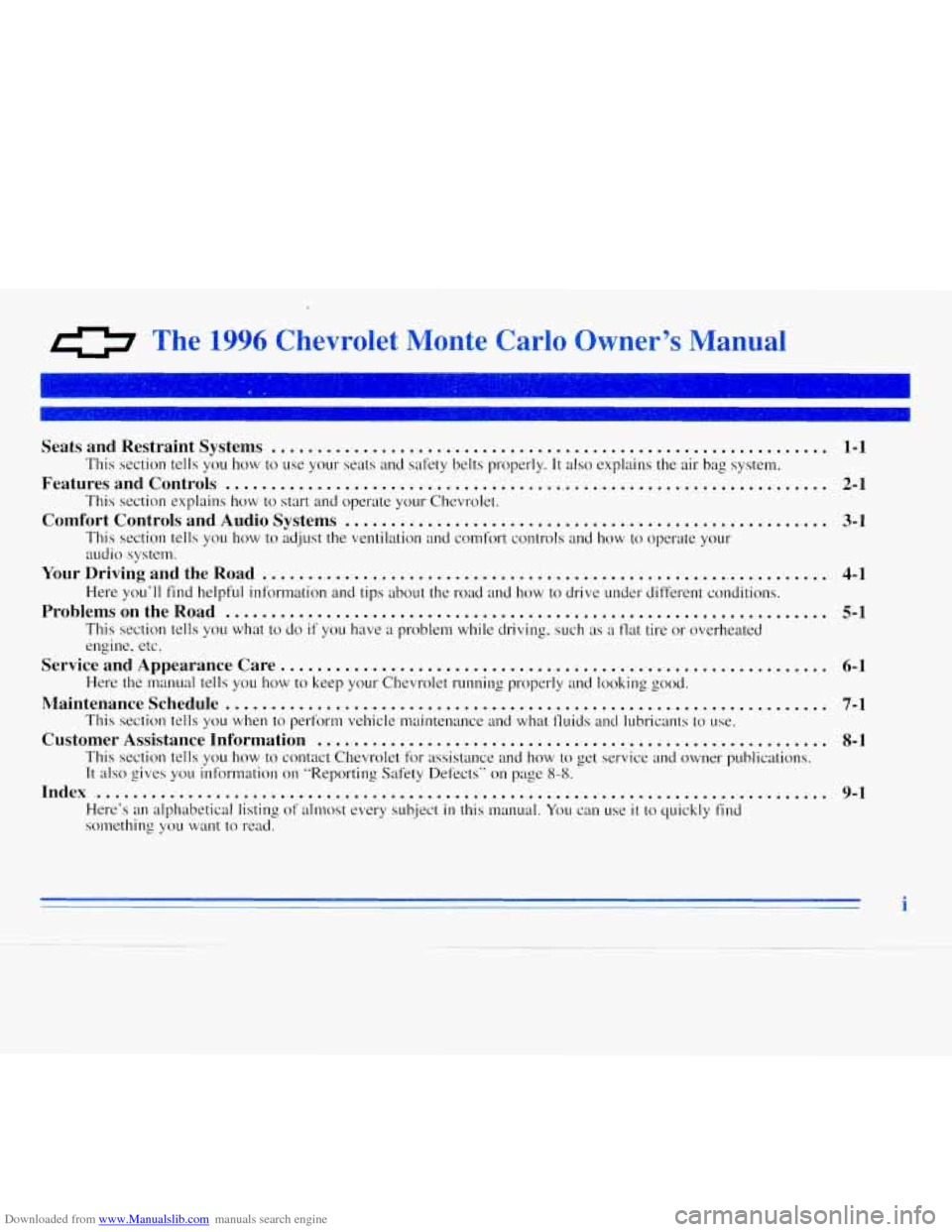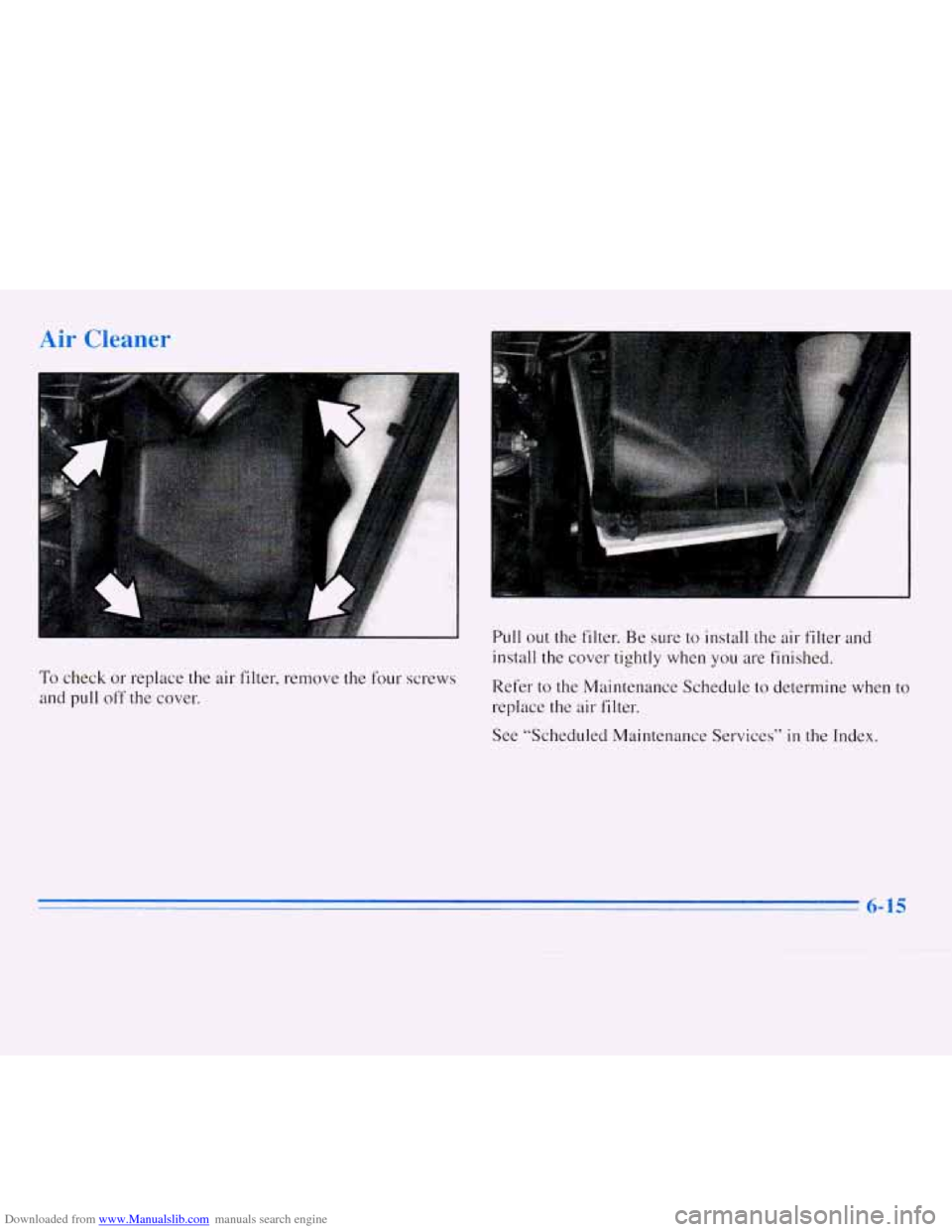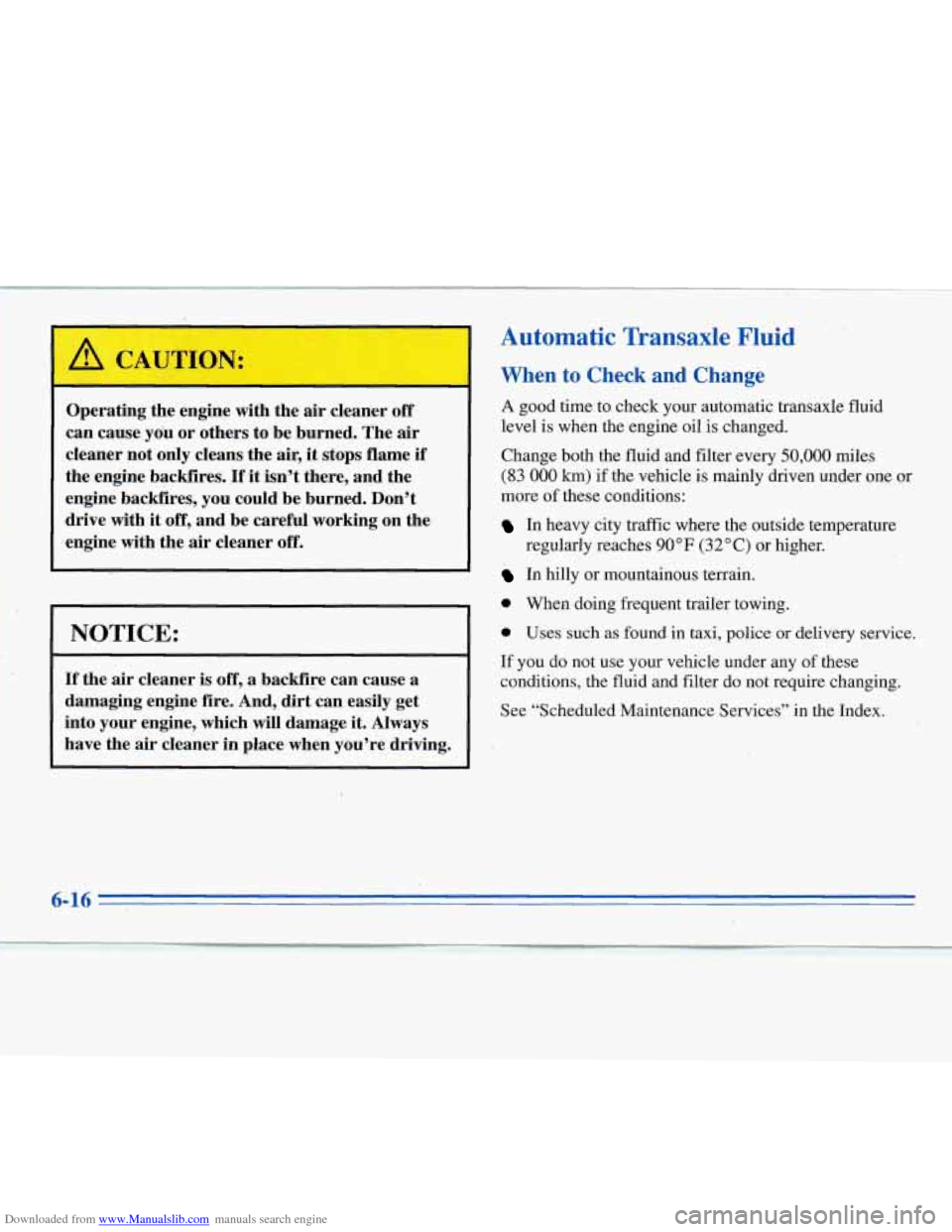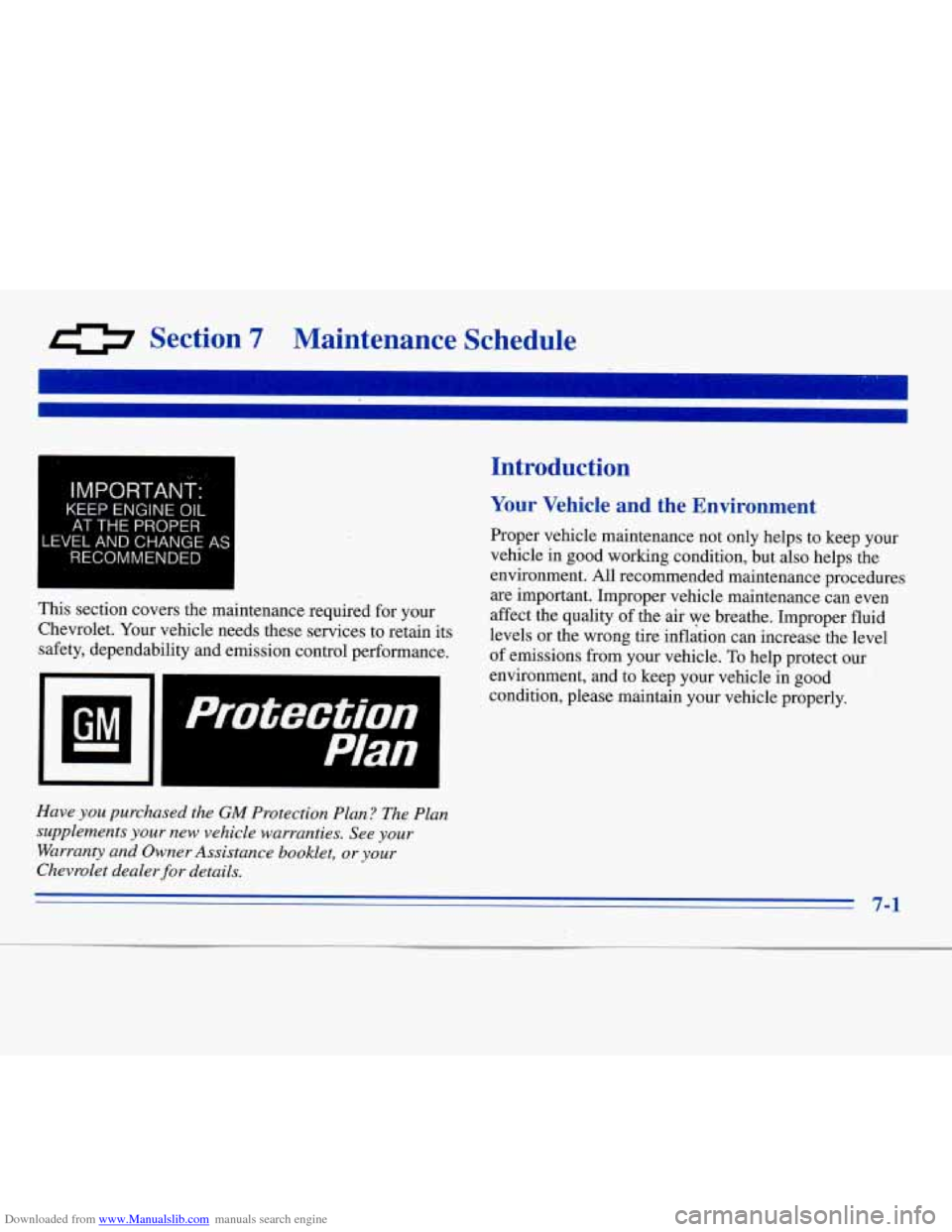1996 CHEVROLET MONTE CARLO service schedule
[x] Cancel search: service schedulePage 3 of 340

Downloaded from www.Manualslib.com manuals search engine d> The 1996 Chevrolet Monte Carlo Owner’s Manual
Seats and Restraint Systems ............................................................. 1-1
Features and Controls
.................................................................. 2-1
Comfort Controls and Audio Systems
..................................................... 3-1
This section tells you how to use your seats and safety belts properly. It also explains the air bag system.
This section explains how
to start and operate your Chevrolet.
This section tells
you how to adjust the ventilation and comfort controls and how lo operate your
audio system.
Here
you’ll find helpful information and tips about the road and how to drive under different conditions.
This section tells you what
to do if you have a problem while driving, such as a tlat tire or overheated
engine, etc.
Here
the manual tells you how to keep your Chevrolet running properly and looking good.
This section tells you when
to perform vehicle maintenance and what fluids and lubricants to use.
This section tells you how
to contact Chevrolet for assistance and how to get service and owner publications.
It also gives you information on “Reporting Safety Defects” on page 8-8.
Index ........................................................................\
........ 9-1
Here‘s an alphabetical listing of almost every subject in this manual. You can use it to quickly find
something you want to read.
YourDrivingandtheRoad .............................................................. 4-1
ProblemsontheRoad .................................................................. 5-1
ServiceandAppearanceCare ............................................................ 6-1
Maintenanceschedule
.................................................................. 7-1
Customer Assistance Information
........................................................ 8-1
i
Page 170 of 340

Downloaded from www.Manualslib.com manuals search engine Parking on Hills
You really should not park your vehicle, with a trailer
attached, on a
hill. If something goes wrong, your rig
could start to move. People can be injured, and both
your vehicle and the trailer can be damaged.
But if you ever have to park your rig on a hill, here’s
how to do
it:
1.
2.
3.
4.
5.
Apply your regular brakes, but don’t shift into
PARK (P)
yet.
Have someone place chocks under the trailer wheels.
When the wheel chocks are in place, release the
regular brakes
until the chocks absorb the load.
Reapply the regular brakes.
Then apply your parking
brake, and then shift
to PARK (P).
Release the regular brakes.
When You Are Ready to Leave After
Parking
on a Hill
1. Apply your regular brakes and hold the pedal down
while
you:
Start your engine;
Shift into a gear; and
Release the parking brake.
2. Let up on the brake pedal.
3. Drive slowly until the trailer is clear of the chocks.
4. Stop and have someone pick up and store the chocks.
Maintenance When Trailer Towing
Your vehicle will need service more often when you’re
pulling
a trailer. See the Maintenance Schedule for more
on this. Things that are especially important
in trailer
operation are automatic transaxle fluid (don’t overfill),
engine oil, belts, cooling system and brake adjustment.
Each of these is covered
in this manual, and the Index
will help you find them quickly. If you’re trailering, it’s
a good idea to review these sections before you start
your trip.
Check periodically to
see that all hitch nuts and bolts
are tight.
Page 223 of 340

Downloaded from www.Manualslib.com manuals search engine Air Cleaner
To check or replace the air filter, remove the four screws
and pull
off the cover. Pull
out the filter. Be sure to install the air filter and
install the cover tightly when you are finished.
Refer to the Maintenance Schedule to determine when to
replace the air filter.
See “Scheduled Maintenance Services”
in the Index.
6-15
Page 224 of 340

Downloaded from www.Manualslib.com manuals search engine -
,A CAUTION:
Operating the engine with the air cleaner off
can cause you or others to be burned. The air
cleaner not only cleans the air, it stops flame if
the engine backfires. If it isn’t there, and the
engine backfires, you could be burned. Don’t
drive with
it off, and be careful working on the
engine with the
air cleaner off.
NOTICE:
If the air cleaner is off, a backfire can cause a
damaging engine fire. And, dirt can easily get
into your engine, which will damage it. Always
have the air cleaner in place when you’re driving.
Automatic Transaxle Fluid
When to Check and Change
A good time to check your automatic transaxle fluid
level is when the engine oil is changed.
Change both the fluid and filter every
50,000 miles
(83 000 km) if the vehicle is mainly driven under one or
more
of these conditions:
In heavy city traffic where the outside temperature
In hilly or mountainous terrain.
0 When doing frequent trailer towing.
0 Uses such as found in taxi, police or delivery service.
If you do not use your vehicle under any of these
conditions, the fluid and filter do not require changing.
See “Scheduled Maintenance Services’’ in the Index.
regularly reaches
90°F (32°C) or
higher.
6-16 .
Page 246 of 340

Downloaded from www.Manualslib.com manuals search engine When to Check
Check your tires once a month or more.
Don’t forget your compact spare tire. It should be at
60 psi (420 kPa).
How to Check
Use a good quality pocket-type gage to check tire
pressure. You can’t tell if your tires are properly inflated
simply by looking at them. Radial tires may look
properly ‘inflated
even when they’re underinflated.
Be sure to put the valve caps back
on the valve stems.
They help prevent leaks by keeping out dirt and moisture.
Tire Inspection and Rotation
Tires should be inspected every 6,000 to 8,000 miles
(10 000 to 13 000 km) for any signs of unusual wear.
If unusual wear is present, rotate your tires as soon as
possible and check wheel alignment. Also check for
damaged tires
or wheels. See “When It’s Time for New
Tires’’ and “Wheel Replacement” later in this section for
more information. The purpose
of regular rotation
is to achieve more
uniform wear for
all tires on the vehicle. The kt
rotation is tlle most important. See “Scheduled
Maintenance Services”
in the Index for scheduled
rotation intervals.
Whcn rotating your tires,
always use the correct rotation
pattern
shown here.
Don’t include the compact spare tire
in your tire rotation.
u-30
Page 273 of 340

Downloaded from www.Manualslib.com manuals search engine 0 Section 7 Maintenance Schedule
IMPORTANT:"
KEEP ENGINE OIL
AT THE
PROPER
-EVEL AND CHANGE AS
RECOMMENDED
I
Introduction
Your Vehicle and the Environment
Proper vehicle maintenance not only h,elps to keep your
vehicle in good working condition, but also helps the
environment.
All recommended maintenance procedures
are important. Improper vehicle maintenance can even
This section covers the maintenance required for your affect
the quality of the air we breathe. Improper fluid
Chevrolet. Your vehicle needs these services to retain its
levels or the wrong tire inflation can increase the level
safety, dependability and emission control performance.
of emissions from your vehicle. TO help protect our
environment, and to keep your vehicle in good
condition, please maintain your vehicle properly.
protection Plan I
Have you purchased the GM Protection Plan ? The Plan
supplements
your new vehicle warranties. See your
Warranty and Owner Assistance booklet, or your
Chevrolet dealer for details.
7-1
Page 274 of 340

Downloaded from www.Manualslib.com manuals search engine I
L
How This Section is Organized
The remainder of this section is divided into five parts:
“Part A: Scheduled Maintendnce Services”
shows what to have done and how often. Some of these
services can be complex,
so unless you are technically
qualified and have the necessary equipment, you should
let your dealer’s service department or another qualified
service center do these jobs.
Performing maintenance work on a vehicle can
be dangerous.
In trying to do some jobs, you can
be seriously injured.
Do your own maintenance
work only if you have the required know-how
and the proper tools and equipment for the job.
If you have any doubt, have a qualified
technician do the work.
11 you are skilled enough to do some work on your
vehicle, you will probably want to get the service
information
GM publishes. See “Service and Owner
Publications” in the Index.
‘Tart B: Owner Checks and Services” tells you what
should be checked whenever you stop for.
hel. It also,
explains. what you can easily do to\help keep your
vehicle in good condition.
‘Tart C: Periodic Maintenance Inspections” ’
explains important inspections that your Chevrolet
dealer’s service department
or an~ther qualified service
“center should perform.
“Part D: Recommended Fluids and LubricmtP
lists some product8 GM recommends to help keep YOLK
vehicle properly maintained. These products, or theh
equivalents, should be used whether yola do the work .
yoursel€ or have it done.
,.
“Part E: Maintenance Record” provides a place
for you to record the ‘maifltenance performed on your
vehicle. Whenever any maintenance is
performed, be
sure to; write it down in this pari. This will,help’you I
determine whin your next mainten&nce should be- done.
In addition, it
is a good idea to keep your maintenance
receipts. They may
.be needed to quahfy your vehicle for
Page 275 of 340

Downloaded from www.Manualslib.com manuals search engine Part A: Scheduled Maintenance
Services
Using Your Maintenance Schedule
We at General Motors want to help you keep your
vehicle
in good working condition. But we don’t know
exactly how you’ll drive
it. You may drive very short
distances only
a few times a week. Or you may drive
long distances all the time in very hot, dusty weather.
You may use your vehicle in making deliveries.
Or
you may drive it to work, to do errands or in many
other ways.
Because of all the different ways people use their GM
vehicles, maintenance needs vary.
You may even need
more frequent checks and replacements than you’ll find
in the schedules in this section. So please read this
section and note how you drive.
If you have any
questions
on how to keep your vehicle in good
condition, see your Chevrolet dealer.
This part tells you the maintenance services you should
have done and when you should schedule them. If you
go to your dealer for your service needs, you’ll know
that GM-trained and supported service people will
perform the work using genuine GM parts. The
proper fluids and lubricants to use are listed
in Part D.
Make sure whoever services your vehicle uses these. All
parts should be replaced and all necessaly repairs done
before you or anyone else drives
the vehicle.
These schedules are for vehicles that:
carry passengers and cargo within recommended
limits. You will find these limits on
your vehicle’s
Tire-Loading Information label. See “Loading
Your Vehicle”
in the Index.
are driven on reasonable road surfaces within legal
driving limits.
use the recommended fuel. See “Fuel” in the Index.
Selecting the Right Schedule
First you’ll need to decide which of the two schedules is
right for your vehicle. Here’s how to decide which
schedule to follow:
7-3